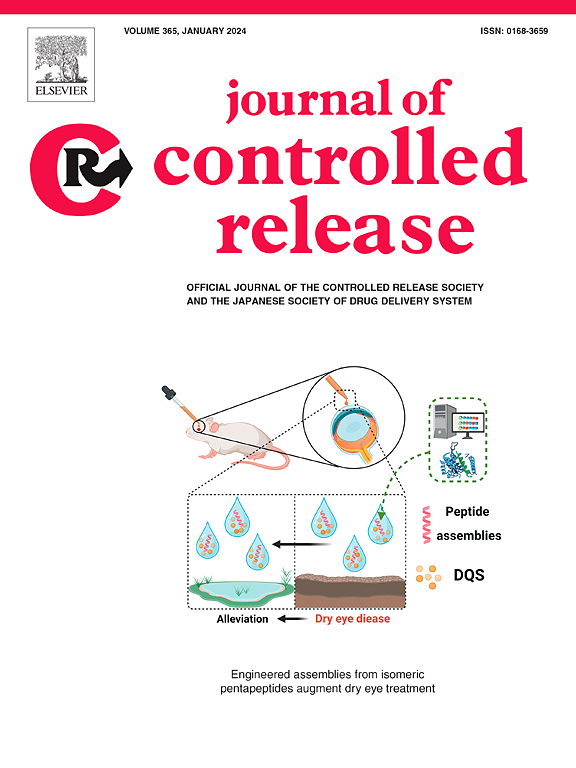In vivo delivery of antioxidant enzymes with multi-functionalized lipid nanoparticles for sepsis therapy
IF 10.5
1区 医学
Q1 CHEMISTRY, MULTIDISCIPLINARY
引用次数: 0
Abstract
Supplementing the cell with specific proteins is essential for disease prevention and therapy. However, protein permeability to the cell membrane is quite low because of the molecules large size and hydrophilic nature. Although protein delivery systems have been developing using vectors, their protein encapsulation efficiency depends on electrostatic interaction between proteins and vectors. Since proteins have a weaker net charge high affinity between vector and protein cannot be realized, and thus the encapsulation efficiency of naked proteins into vector is low. Herein, we developed a strategy for delivering target proteins into cells utilizing multifunctionalized lipid nanoparticles (MF-LNPs) prepared using several functional lipids that induce noncovalent interactions. We used two types of antioxidant enzymes, superoxide dismutase (SOD) and catalase (CAT), as model proteins for inflammation therapy. MF-LNPs are prepared by combining positively charged, neutral, and hydrophobic group-functionalized lipids. Optimization of the functional lipid composition alone resulted in MF-LNPs exhibiting nM affinity for SOD and CAT. Proteins were encapsulated in each optimized MF-LNP by freeze-thawing of MF-LNP and protein complexes. Co-treatment with SOD- and CAT-encapsulated MF-LNPs significantly inhibited ROS production in vitro and in vivo. Notably, the survival rate of model mice with severe sepsis was dramatically improved following the co-administration of SOD- and CAT-encapsulated MF-LNPs through the suppression of inflammatory cytokines and improvement of ROS scavenging activities. The findings indicate that this fundamental technology could be useful information for designing protein delivery vectors.


利用多功能脂质纳米颗粒在体内输送抗氧化酶,用于败血症治疗
为细胞补充特定的蛋白质对于疾病的预防和治疗是必不可少的。然而,由于蛋白质分子的大尺寸和亲水性,蛋白质对细胞膜的渗透性很低。虽然利用载体的蛋白质传递系统已经得到了发展,但其蛋白质封装效率取决于蛋白质与载体之间的静电相互作用。由于蛋白质具有较弱的净电荷,因此无法实现载体与蛋白质之间的高亲和力,从而使裸蛋白封装到载体中的效率较低。在此,我们开发了一种利用多种诱导非共价相互作用的功能性脂质制备的多功能脂质纳米颗粒(MF-LNPs)将靶蛋白递送到细胞中的策略。我们使用超氧化物歧化酶(SOD)和过氧化氢酶(CAT)两种抗氧化酶作为炎症治疗的模型蛋白。MF-LNPs是通过结合带正电、中性和疏水基团功能化的脂质制备的。优化功能性脂质组成,使MF-LNPs对SOD和CAT具有nM亲和力。将优化后的MF-LNP与蛋白复合物冻融后包裹蛋白。与SOD和cat包封的MF-LNPs共处理可显著抑制体外和体内ROS的产生。值得注意的是,通过抑制炎症细胞因子和提高活性氧清除能力,SOD-和cat包封的MF-LNPs共同给药后,严重脓毒症模型小鼠的存活率显著提高。研究结果表明,这一基础技术可以为设计蛋白质传递载体提供有用的信息。
本文章由计算机程序翻译,如有差异,请以英文原文为准。
求助全文
约1分钟内获得全文
求助全文
来源期刊

Journal of Controlled Release
医学-化学综合
CiteScore
18.50
自引率
5.60%
发文量
700
审稿时长
39 days
期刊介绍:
The Journal of Controlled Release (JCR) proudly serves as the Official Journal of the Controlled Release Society and the Japan Society of Drug Delivery System.
Dedicated to the broad field of delivery science and technology, JCR publishes high-quality research articles covering drug delivery systems and all facets of formulations. This includes the physicochemical and biological properties of drugs, design and characterization of dosage forms, release mechanisms, in vivo testing, and formulation research and development across pharmaceutical, diagnostic, agricultural, environmental, cosmetic, and food industries.
Priority is given to manuscripts that contribute to the fundamental understanding of principles or demonstrate the advantages of novel technologies in terms of safety and efficacy over current clinical standards. JCR strives to be a leading platform for advancements in delivery science and technology.
 求助内容:
求助内容: 应助结果提醒方式:
应助结果提醒方式:


